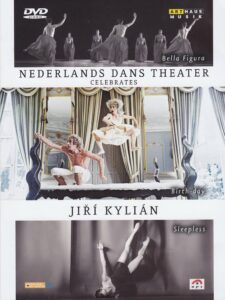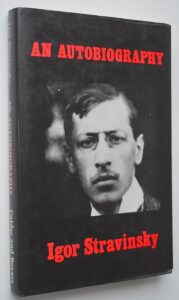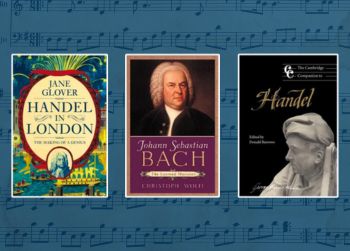On Saturday night, Orchestra Wellington will open its 2024 Season with a Grand Gesture, a programme that lays down the foundation for the Orchestra’s exploration of The Story, ‘a glimpse of the journey of orchestral music from the Baroque era to the music of today.’ This is a story with many plot twists: far from being a chronological tour of well-known works that lead us from the eighteenth to the twenty-first century, music director Marc Taddei’s programming considers how composers in each era looked back at the history of music for inspiration, using the models established by past masters to guide their modern inventions. In the first concert, you’ll hear music by two of the 1685 generation, J. S. Bach and G. F. Handel, alongside Igor Stravinsky’s Pulcinella Suite and the Baroque Variations of Lukas Foss. If you’re eager to learn more about these composers and their music, read on … Wellington City Libraries holds a wealth of material that will enrich the story.
Handel’s Concerto Grosso in B minor, Op. 6, No. 12, and Bach’s Concerto in D minor for Two Violins and Orchestra, BWV1043 are firmly ensconced in the Western art music canon. Both composers played a fundamental role in the development of orchestral music, their concertos utilizing the Italian models of the concerto grosso perfected by Arcangelo Corelli, and the solo instrumental concerto epitomized by Antonio Vivaldi. Indeed, Handel’s Opus 6, published in 1739, contains a set of twelve concerti just like Corelli’s Op. 6, published in 1714. Handel’s work draws on the crystalline vivacity of Corelli’s music but adds to it the French flavour found in the grand opening gestures of the first movement. Meanwhile, Bach’s Concerto in D minor looks to Vivaldi’s Venetian concerti for one, two, or more soloists and orchestra, but enhances those ideas with complex counterpoint: the soloists and orchestra weave their paths through a musical labyrinth, worked out with perfect logic.
In the early twentieth century, Igor Stravinsky astonished Paris with the ferocious modernism of The Rite of Spring, the third great collaboration with Diaghilev’s Ballets Russes. However, following the cataclysmic 1914-1918 War, Stravinsky sought new sources of motivation. In 1919, keen to reignite the fortunes of the Ballets Russes, Diaghilev offered Stravinsky a manuscript he had found in Italy, containing music by Pergolesi (although more of it was the work Domenico Gallo, and Wilhelm von Wassenaer). Diaghilev suggested a collaboration between Stravinsky and Pablo Picasso on a new ballet inspired by the commedia dell’arte story of Pulcinella and choreographed by Léonide Massine. The prospect of working with Picasso proved irresistible to Stravinsky, who embarked upon a transformation of the eighteenth-century music: he concentrated on metric manipulation, electrifying the harmony, and employing imaginative instrumentation to colour the witty score. Inspired by Picasso, Stravinsky aimed at a dazzling collision of cubism and commedia dell’arte:
‘I began by composing on the Pergolesi manuscripts themselves, as though I were correcting an old work of my own. I began without preconceptions or aesthetic attitudes, and I could not have predicted anything about the result. I knew I could not produce a “forgery” of Pergolesi because my own motor habits are so different; at best, I could repeat him in my own accent.” — Igor Stravinsky
Stravinsky preserved the melodic material of Pergolesi, Gallo, and Wassenaer, utilising concerto grosso textures (in which a small group of soloists—the concertino—emerge from the larger ensemble, or ripieno); he also introduced a duet between the trombone and double bass, and demanded ricochet bowing from the strings (a technique involving throwing or bouncing the bow).
The premiere of the ballet Pulcinella took place in Paris in May 1920, and the Boston Symphony Orchestra gave the first performance of the Suite in December 1922. Stravinsky recalled that he was attacked for ‘being a pasticheur, chided for composing “simple” music, blamed for deserting “modernism,” [and] accused of renouncing my “true Russian heritage.” In fact, Stravinsky’s Pulcinella had sent modernism along an entirely new path, although a path that some criticised harshly:
‘Pulcinella was my discovery of the past, the epiphany through which the whole of my late work became possible. It was a backward look, of course—the first of many love affairs in that direction—but it was a look in the mirror, too.” — Igor Stravinsky
I was … attacked for being a pasticheur, chided for composing ‘simple’ music, blamed for deserting “modernism”, accused of renouncing my ‘true Russian heritage’. People who had never heard of, or cared about, the originals cried ‘sacrilege’: ‘The classics are ours. Leave the classics alone.’ To them all my answer was and is the same: You ‘respect’, but I love.” — Igor Stravinsky
If it appeared to some that Stravinsky committed theft by finding with his Pulcinella, they would have been rendered speechless by the Baroque Variations of the German-born American composer Lukas Foss (1922–2009). Baroque Variations premiered in 1967, and its three movements ingeniously plunder a larghetto by Handel, a keyboard sonata by Domenico Scarlatti, and the Prelude to Bach’s Partita in E major for Solo Violin. Utilising a full orchestra enlarged by an electric guitar, a breaking bottle, and a plethora of other effects, Foss’s score deconstructs and reconstructs three pieces by the 1685 generation with a wit that belies the extraordinary skill required to work such feats.
The social context in which these composers contributed to the story of orchestral music was important in shaping their work, and many of the books and recordings that illustrate this history are currently on display at Te Awe Library, where you can view and borrow them. Alternatively, you can place the material of your choice on reserve. Here is a brief digest of some of the material available:

Johann Sebastian Bach : the Learned Musician / Wolff, Christoph
Christoph Wolff —a former director of the Leipzig Bach Archive, and an emeritus professor of music at Harvard University — is the author of several significant works about Johann Sebastian Bach. Johann Sebastian Bach: the Learned Musician was first published in 2000, coinciding with the 250th anniversary of the composer’s death. Wolff’s goal was to write a book going beyond the parameters of a ‘life and works’ study: he guides the reader through Bach’s life from cradle to grave, but does so by using a wealth of primary sources demonstrating that for Bach, music formed part of a far broader intellectual profile: logic, philosophy, science, and theology were all implicated in Bach’s systematic and ‘scientific’ approach to composition. Wolff argues that only through Bach’s rigorous application of ‘scientific’ method did he discover the means of creating—in the words of his son Carl Philipp Emanual Bach— ‘strange, new, expressive and beautiful ideas’ in his music. Wolff’s methods of synthesizing a plethora of primary sources have produced a book that is fascinating to read as a whole or explore in smaller portions. He transports readers from the Himmelsburg (‘heaven’s castle’) that was the palace church in Weimar to Zimmermann’s coffee house in the Catherinenstrasse of Leipzig, and leaves us with Mozart’s joyful exclamation upon hearing Bach’s motet Singet dem Herrn: ‘Now there is something one can learn from!’
 Bach’s Musical Universe : the Composer and his Work / Wolff, Christoph
Bach’s Musical Universe : the Composer and his Work / Wolff, Christoph
Bach’s Musical Universe, Wolff’s ‘concentrated study of Bach’s creative output’ is a companion work to The Learned Musician in which Wolff turns his attention to a ‘limited but highly significant array of works’ that ‘cuts across … conventional boundaries’ in a manner he feels Bach had himself determined. These are works that Wolff believes Bach wanted to ‘stand as paradigms of his musical art’ and thus serve as ‘perhaps the most powerful and authentic musical autobiography imaginable.’ Within this context the Concerto in D minor for two violins has a special place during a time in Leipzig when Bach turned his focus to new possibilities for instrumental music. In such pieces as the Double Concerto’ Bach experimented with structures of multiple-soloist concerti by Vivaldi, synthesizing the grand gestural drama of Vivaldi’s works with the ‘primacy and pervasiveness of polyphony’ that Wolff cites as Bach’s ‘business card’. Again, Wolff wears his erudition lightly, drawing his readers into the story of Bach’s musical life.
Handel in London : a genius and his craft / Glover, Jane
Conductor and scholar Jane Glover charts the growth of Handel’s career in London, the city he made his home. Glover’s very readable text examines Handel’s composing life, the challenges, rivalries, and feuds of the music business. Handel’s interactions with other composers, singers, the nobility, and the public illustrate that the story of music is also a social story: the composer’s creativity is inextricably connected with wider philosophical, literary, and political preoccupations of mid-eighteenth-century London, as well as with the musical past. The set of ‘Twelve Grand Concertos’ of Op. 6 that Handel composed for the 1739-1740 season at Lincolns Inn Theatre, was a part of this story, responding to the desires of the public and his publisher, while also demonstrating Handel’s command of the concerto grosso structure. Glover’s book, informed by her long experience performing Handel’s music possesses great appeal for committed Handel enthusiasts and newcomers to his music.
 The Cambridge companion to Handel
The Cambridge companion to Handel
The collection of essays in this Cambridge Companion to Handel examines the composer’s life, career, and compositions. Each contributing author is an expert on Handel, and they write with precision and clarity about individual works, such as the oratorios and operas, as well as issues of performance practice, compositional process, Handel’s approach to setting the English and Italian languages in his operas and oratorios, and his early experiences in Italy. Most relevant to ‘The Grand Gesture’ will be Donald Burrows’s essay on Handel as a concerto composer, and Mark W. Stahura’s contribution concerning Handel and the orchestra. These essays also complement Jane Glover’s Handel in London by offering more detail about individual musical works, a comprehensive chronology of Handel’s life, and a complete list of his compositions.
 A passionate journey : a memoir / Mann, Robert
A passionate journey : a memoir / Mann, Robert
Although Wellington City Libraries hold few resources directly pertaining to the work of Lukas Foss, he makes appearances here and there. One such brief appearance occurs in Robert Mann’s A Passionate Journey, a memoir of Mann’s formative years and fifty-one-year career with the Julliard String Quartet. Foss is one of the many musical luminaries who appear in this engaging book in which Mann has assembled an array of essays, letters, lectures, and transcribed interviews to give his readers a glimpse at the life of a remarkable violinist.
Nederlands Dans Theater celebrates Jiří Kylián
Jiří Kylián’s Bella Figura is the first piece in this triple-bill celebration of the Czech choreographer by the Netherlands Dance Theatre: the ballet is set to music by Pergolesi, Marcello, Vivaldi, Torelli, and Lukas Foss. Kylián has described Bella Figura as ‘A journey in time—light and space, addressing the ambiguity of aesthetics’. An abstract work, Bella Figura asks where the performing act begins and ends, the ‘moment in which dream intrudes into our lives and life into our dreams—this is the point of my curiosity. Simply—a feeling of falling down in a dream and waking up with a broken rib.’ Kylián begins Bella Figura with the slow fifth movement of Foss’s Salomon Rossi Suite (1974). This ingenious choice sounds ‘authentically’ baroque … until it doesn’t … and thus establishes the liminal mood of the ballet.
 AN AUTOBIOGRAPHY/ Stravinsky, Igor
AN AUTOBIOGRAPHY/ Stravinsky, Igor
Stravinsky wrote his autobiography, covering the years from his birth until 1945, in French and with the assistance of Walter Nouvel. Initially published in Paris with the title Chroniques de ma Vie, an English edition followed a year later in London, and in New York, Simon & Schuster also published an English version in 1936. The Autobiography gives us an insight into Stravinsky’s perception of his childhood and musical training, and his experiences as he became one of the best-known composers of the twentieth century. In the foreword, Stravinsky stated his desire to ‘set down a few recollections connected with various periods of my life …. Naturally I shall not be able to keep within the bounds of bare statement. As I call my recollections to mind, I shall necessarily be obliged to speak of my opinions, my tastes, my preferences, and my abhorrences.’ These are the qualities that most readers would want to find in an autobiography, and Stravinsky obliges them with vigour; the second chapter opens with the unforgettable, sentence, ‘I picture the first years of my adolescence as a series of irksome duties and the perpetual frustration of all my desires and aspirations.’ Later in the Autobiography he documents the genesis of Pulcinella in detail, writing of ‘Frequent conferences with Diagileff [sic], Picasso, and Massine,’ the conflict when the music Stravinsky offered did not match his colleagues’ vision for the choreography and design, and the eventual success of the project. Stravinsky’s Autobiography is integral to greater story of music in the twentieth century.
Behind the Scenes at the Ballets Russes : stories from a golden age / Meylac, Michael
This book explores a later period than the time when Stravinsky composed Pulcinella, but Michael Meylac grew up attending ballet performances at the Mariinsky and Maly Theatres in St Petersburg (then Leningrad) and counted among his and his parents’ friends dancers who illuminated for the history of dance in Imperial Russia and during the time of the Revolution. Through these contacts, Meylac developed a fascination with the Ballets Russes. After 1989, when Meylac was free to travel the world, he sought out dancers of earlier generations—along with painters, choreographers, and others—who had been part of the Ballets Russes, and through these ‘accumulated conversations’ Behind the Scenes at the Ballets Russes developed. One such encounter was with Jean Babilée, who had studied with Alexandre Volinine (a one-time dancer with the Ballets Russes) and would later work alongside Serge Lifar (the ‘successor’ to Nijinsky at the Ballets Russes) at the Paris Opera. Jean Babilée recalled dancing in Léonide Massine’s Pulcinella with the choreographer present at rehearsals, an awe-inducing experience to work on the ballet with its creator: Massine, Babilée said, attended rehearsals with a ‘large notebook in front of him full of old notes and drawings …. These pages provided him with ideas.’ Vignettes such as these illustrate vividly the continuities and connections in the story of music and dance.
Stravinsky : a creative spring : Russia and France, 1882-1934 / Walsh, Stephen
In the first installment of his two-volume biography of Igor Stravinsky, Stephen Walsh examines the composer’s early life, covering roughly the same period as Stravinsky’s Autobiography. Reading A Creative Spring alongside Stravinsky’s Chroniques adds plentiful detail and several clarifications to Stravinsky’s avowedly subjective account of his early life, useful when the composer has been acknowledged as a beguiling but unreliable narrator. Walsh highlights the relationship between Stravinsky’s pragmatism and business sense, his aesthetics, and his identity as a Russian composer outside his mother country. Walsh’s work also includes a more detailed account of Stravinsky’s archival adventures that brought him to the baroque music he’d transform in Pulcinella. Critical reactions to Pulcinella—both the ballet and the suite—add to our understanding of how this music changed perceptions of Stravinsky as a modernist: in his approach to the music of the past, composer Reynaldo Hahn declaimed that Stravinsky had ‘never given proof of greater talent than in Pulcinella, nor of a surer taste in audacity.’ Walsh concludes that with this audacity he had reestablished himself as the ‘most chic and brilliant modernist-the supreme genius of the unexpected, in that age of the artist as illusionist and magician.’


